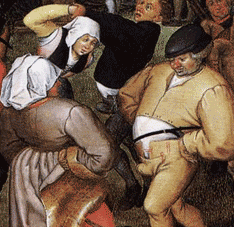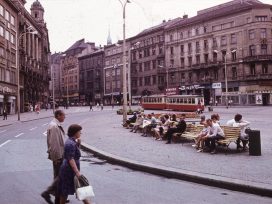
Writing is a known tool for healing trauma. And poetry lends itself to rapid responses under pressure. Forced into migrating to flee war, many Ukrainian women turn to the short form as a call of solidarity, a weapon and solace.
Author Janice Galloway reveals her lifelong fascination with Pieter Breugel the Younger, whose love of the “ordinary”, she believes, chimes with the Scottish character.
As a child, I knew what I loved. Pictures and growing things, words and animals – any or all of these and I was in seventh heaven. Animals delighted in their openness and purpose: curious, non-judgmental and never prey to self-pity, they simply were. Coloured pencils to draw with, flowers, trees and folk tales, yielded delight for much the same reason. All could be played with. I had no desire for exotica, for everything was exotic by default; new, fresh-peeled and incontrovertibly present. That intense pleasure in my own back yard remained till I reached puberty, when – as happens with so many of us – a notion of more insinuated its way into a craving and would not insinuate back out. I had no idea what kind of more I wanted, or even what it looked like, but I lusted after it anyway, sure it was out there somewhere, waiting for me to find and pluck it, straight from the tree. And by somewhere, I meant somewhere else. The local was, or so I thought, seen-it-all territory: like mangoes, more might be found only further, much further, afield.
To help, my aunt and uncle hit on the idea of taking me, as a birthday treat, to the bright lights of Glasgow with £2 to spend. Millers – Queen Street, just off the bustle of George Square – was where genuine out-in-the-world art students went to buy supplies, and, knowing I loved drawing, it seemed an ideal place to drop me off. I was fifteen, clueless and drunk on the smell of linseed from the moment I opened the door. Inside were walls of specialised, beautifully-packaged, colour-blazoned stuff. There were inks and chalks, charcoal and 6Bs, brushes in hog, squirrel and sable; bottles of oil and albumen and varnish and turpentine like ingredients for a secret spell and jars of powders whose purpose eluded me altogether. Even the paints were mysterious: so many types! From watercolours wrapped in foil-backed blocks to fat tubes of acrylics, oils and gouaches and on again to tiny pots of lacquer, enamel, finishes and topcoats. The only bad bit was on the price labels. Everything cost a fortune, and £2 was not going to make much of an impression on what I’d need to begin. More, it seemed, was not to be mine in this shop, unless… unless I found it another way. In something smaller, more contained; something complete in itself yet full of possibility. And that meant – it always meant – a book.
Which then? Something about perspective or anatomy for beginners? Composition or a guide to the use of the colour-wheel? How to reproduce the effects of texture and shade? What saved me from giving up here too was a slim volume, its cover facing out, with three naked women parading on the front. Normally, a picture like that would have been embarrassing. This wasn’t. The women, when I held them closer, were far too perfect, and each held a veil that looked little more than a trick of the light, hiding nothing of her impossibly beautiful form. They were, I thought, the stuff of fairy tales: something beyond ordinary. What’s more, the volume was called Renaissance Painting: one volume of six, suggesting I could buy one now, and more on future birthdays. As a final check it was what I wanted, I opened it and looked inside. There were goddesses and other-worldly beings in ethereal landscapes; classical and biblical legends in exotic surrounds; high-born individuals gazing serenely out of portraits, either individually or in small groups, wearing their very best duds. Some paintings showed the artist’s patrons in clusters, surreal side-kicks, in attendance at Christ’s birth or death, as if it was possible to buy one’s way into history. There were saints with golden haloes, the sufferings of the damned and loads of the baby Jesus with his mum. The latter often had animals into the bargain, but so many of them, people and beasts alike, were self-conscious or oddly posed. Then there was Pieter Breugel. His paintings looked like none of the rest. Too plain, I thought, too ordinary: just normal landscapes populated by the kind folk I could see any time at home. For the sake of the fairies and nymphs, then – more on a pedestal – I bought the book. I have it still, almost forty years later. And the most thumbed pages, the ones that open flat at the merest nudge, are the Breugels; those paintings of ordinary things I took time to learn were not ordinary at all.
 There was a winter landscape with hunters with their dogs, stark and heart lurchingly familiar as Scottish gamekeepers, yet from another place and time; a crowded wedding scene with platters of what looked like pancakes being brought to the pink-cheeked, tipsy bride’s table by waiters whose shape bore testimony to the deliciousness of their burden; scenes of fairs and rituals and village life. And what life! Toddlers, the aged and the in-between; the able bodied and the war-maimed; the weird and the grim and the frankly ludicrous (did that drunk, dancing fat man know his codpiece was doing nothing to conceal his massive allure?); rising to the fore then fading back again as the eye moved on. A woman making waffles with a waffle iron, a bagpiper with a daft hat pulled down over his ears, a flock of scrawny hens, scratching at nothing. It did not take that long for me to work out the delight was in the detail, the sheer teemingness of what there was to see. I had, I realised, been at that wedding and met the bride; I had seen that dancing man and been one of those girls that flared her skirt to a circle on the way home from school. I had watched those boys hanging upside down from the slats of a rickety bridge, waiting for one of them to lose his grip and fall straight in. The more I looked, the more there was to see: most of all, the tenderness and delicacy revealed by the artist’s act of seeing, rendering, bringing to life absorbed me completely. From patient donkeys wanting to be fed to the legless beggar near-trampled under careless feet; from the chap in full military uniform to the duet of bare arses dangling over a stream, he saw it all. In the corner, now and then, he’d place one fleeting glimpse of history as part of the whole: the glory of the Nativity, compressed into a barn corner, or the foot of drowning Icarus, casting the last of his feathers, as all around him passes by.
There was a winter landscape with hunters with their dogs, stark and heart lurchingly familiar as Scottish gamekeepers, yet from another place and time; a crowded wedding scene with platters of what looked like pancakes being brought to the pink-cheeked, tipsy bride’s table by waiters whose shape bore testimony to the deliciousness of their burden; scenes of fairs and rituals and village life. And what life! Toddlers, the aged and the in-between; the able bodied and the war-maimed; the weird and the grim and the frankly ludicrous (did that drunk, dancing fat man know his codpiece was doing nothing to conceal his massive allure?); rising to the fore then fading back again as the eye moved on. A woman making waffles with a waffle iron, a bagpiper with a daft hat pulled down over his ears, a flock of scrawny hens, scratching at nothing. It did not take that long for me to work out the delight was in the detail, the sheer teemingness of what there was to see. I had, I realised, been at that wedding and met the bride; I had seen that dancing man and been one of those girls that flared her skirt to a circle on the way home from school. I had watched those boys hanging upside down from the slats of a rickety bridge, waiting for one of them to lose his grip and fall straight in. The more I looked, the more there was to see: most of all, the tenderness and delicacy revealed by the artist’s act of seeing, rendering, bringing to life absorbed me completely. From patient donkeys wanting to be fed to the legless beggar near-trampled under careless feet; from the chap in full military uniform to the duet of bare arses dangling over a stream, he saw it all. In the corner, now and then, he’d place one fleeting glimpse of history as part of the whole: the glory of the Nativity, compressed into a barn corner, or the foot of drowning Icarus, casting the last of his feathers, as all around him passes by.
Breugel’s love of humanity – at a time when the merely human counted for so very little – astounds me still: his cherishing of our smallness and commonality is profoundly moving at the same time that it draws a smile of recognition. Breugel, every bit as much as Burns or Carver or Duras or any of the other people whose work came to matter deeply to me, taught me it is not fancy or far-flung subject matter, not conventional or even ethereal beauty, that matters in the grand scheme of things, but our extraordinary persistence as human beings. It is as part, and at the most local of levels, connecting with landscape, animals, the seasons and each other, that we count at all. In this he brought me full circle, back to the local. Back, indeed, home.
Scottish countryside is harder to tame than Flanders, perhaps; our history more bound to pragmatic canniness and seesaw governance, but we are equally fascinated by folk as opposed to the notionally Great and Good. Mine is a country of strong egalitarian sentiments yet unsentimental contradiction. It is a place of gorgeous Highland landscape that permits barely a living to be scraped from it; a place where sceptics and molten romantics, free-thinkers and ingenious inventors; farmers and landsmen, cannon-fodder, drunken dregs and dreamy realists come together in single individuals, never mind the population entire. That Breugel saw people as significant in themselves – unexplained and various and simply being – was what rang home. What came, of course, to delight.
This was before I had even visited Flanders for myself.
In October 2009, as a writing resident at Villa Hellebosch in Vollezele, I borrowed a kindly benefactor’s car and kept my eyes open. And there was Breugel, everywhere I looked. In those complacently ugly Brabant sheep for a start: in the flat-backed, square-shouldered marble chunks of cattle that might easily have pulled a medieval plough. The chickens in the area I lived were not the famous Barbu d’Uccle or Belgian Bantam fantasies of champion breeders, but the hybrids that looked, acted and sounded exactly the same as working chickens anywhere – the birds likewise fed by the matrons Breugel noticed at local fairs. Now and then I’d park (probably on the wrong side of the road) to greet goats and stroke the nose of any horse willing to let me while pigeons rustled in the kind of berry bushes that would be nothing but sticks by winter when the hunting dogs went past. And now and then, oddly familiar strangers with woollen hats pulled down over their ears, or sporting flamboyant facial hair, or cocooned in a tight-buttoned jacket barely concealing a vast beer gut, would nod or wave as they passed. Coy and open faced, ruddy with work and good milk, locals going about their business, they carried something wonderful: the faces of the paintings. These, after all, were Breugel’s folk.
I didn’t even have to leave my bedroom. Outside my window, every afternoon and every dusk, a string of pheasants in autumn-leaf disguise strolled by, apparently oblivious to danger. Ragged crows (corbies, as they’re called in Scotland, our national bird) turned raucous at night, as the sky changed from navy to pitch. Even the fruit trees were filled with living things, toy-sized ladybirds growing fat and drunk on over-ripe pears. I could also hear a donkey braying like a creaky hinge, the sound of her carrying over the fields every afternoon, and though I went looking, she remained unseen. I made do instead by braying back, Scottish accent and all. Maybe she’d hear and know, I thought; it was only a stranger, making contact. Alone in those surroundings, then, there was nothing of loneliness. Like a figure in the corner of one of his village scenes, I was surrounded by life itself.
Before going home, I went to Brussels and headed straight from the train to the Musée des Beaux Arts, shivering as I walked into the space that housed the paintings I seemed to have known all my life: the room of Breugels, father and son together, though the only one I really craved was Pieter. They were dark and dignified. Modest. Movingly unassuming. And small. This close, they were very small. I would have wept if I had not been so spellbound by the tumbling figures they contained, the fact that he makes you smile. So I simply sat, letting the experience begun by a little book, bought by a fifteen-year-old girl in Glasgow decades before, fall satisfyingly into place.
And what I know now is this. There is no somewhere else where truer significance resides. We are all of us, from the humblest to the grandest of places and stations, fit subjects for the finest art. Bare-arsed and thinking ourselves unobserved, absurd with our hats about our ears, we have no choice but to share a common fate. It matters, with our animals and our given landscapes, to embrace it. And even if we miss the Big Moments – the Christ child in the barn behind us or who it is that walks, unobserved, beside us on the road – Breugel restores our faith, our dignity: he shows us we were at the least there. His are human dimensions: the local made universal. As it is, as it always is.
Published 3 November 2010
Original in English
First published by Edinburgh Review 130 (2010)
Contributed by Edinburgh Review © Janice Galloway / Edinburgh Review / Eurozine
PDF/PRINTSubscribe to know what’s worth thinking about.

Writing is a known tool for healing trauma. And poetry lends itself to rapid responses under pressure. Forced into migrating to flee war, many Ukrainian women turn to the short form as a call of solidarity, a weapon and solace.

Until almost the very end, Milan Kundera refused to let his work be translated into Czech or Slovak. Now that is changing, he is being rediscovered by a new generation. Although his wish to return was unfulfilled, his work is experiencing a homecoming.